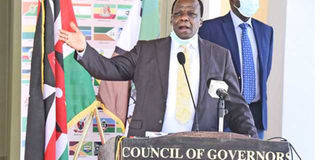Counties the scapegoats in Covid-19 war

Council of Governors Chairman Wycliffe Oparanya addresses the press at his office in Kakamega town on May 13 on Covid-19 preparedness. PHOTO | FILE | NATION MEDIA GROUP
What you need to know:
- The ambulances will only benefit the local communities if the county government doesn’t let its corrupt officials steal the operations money and ground them.
- They have difficulty fixing their wage bill problems that have seen health services frequently disrupted by work boycotts, for example.
My first experience of a public health facility as a little boy was at Nyang’ande Dispensary in Kano, Kisumu County.
With the benefit of my grandfather Daddy’s local navigation skills, we covered about four kilometres walking through Kamkono, Korwana and Kawakungu villages to get there.
Along the way, we had to precariously cross the dancing wooden Miriu river bridge and brave barking dogs by the footpaths that many times led us through homesteads.
The atmosphere at the ‘hospital’ was quite scary. The queue on the bench outside the treatment room grew longer by the minute. Behind the door, the guy in the white coat spent more time sterilising his syringe in loud boiling water than attending to the next patient and was definitely overwhelmed with work.
RECEIVED AMBULANCE
Well, Nyang’ande has since been upgraded into a much better health facility, with more staff and medical equipment.
Last week, it was one of the four health centres that each received an ambulance from the Kisumu County government to improve emergency services.
Of course, the ambulances will only benefit the local communities if the county government doesn’t let its corrupt officials steal the operations money and ground them.
But the fact that rural health facilities like Nyang’ande, which until recently struggled to sterilise their syringes, are revamping emer-gency services suggests remarkable progress in the past eight years of devolution.
During that time, there have been reports of local people elsewhere being attended to by a medical doctor and local hospitals con-ducting their first Caesarean-sections or kidney transplants since independence in 1963.
The counties have had their failures, though.
They have difficulty fixing their wage bill problems that have seen health services frequently disrupted by work boycotts, for example.
Almost all counties struggle to pay their health workers. But the emerging narrative by the national government blaming every public healthcare failure on the counties is ridiculous scapegoating.
Last month, President Uhuru Kenyatta cited lack of Covid-19 isolation beds for his decision not to lift the countrywide night curfew and lockdowns on the Nairobi Metropolitan Area, Mombasa and Mandera.
BLOATED WORKFORCE
Health Cabinet Secretary Mutahi Kagwe took cue and has lately been doing little more than read out positive test results and lecture counties about their responsibilities at his regular media briefings.
The truth is that most of the counties’ problems are related to delays in receiving disbursements from the National Treasury and a bloated workforce inherited from the national government.
The President and his Health minister are themselves part of a system that presided over Kenya’s 50 lost years during which the country only had about 400 ICU beds, most of them in Nairobi.
Like the hypocrite of the Bible, they should first remove the log in their eye before looking at the speck in their brother’s eye.
[email protected].@otienootieno





